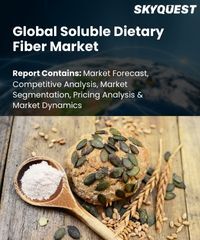
Product ID: SQMIG15A2112

Report ID:
SQMIG15A2112 |
Region:
Global |
Published Date: February, 2024
Pages:
261
|
Tables:
61 |
Figures:
75
Global Soluble Dietary Fiber Market size was valued at USD 46.02 billion in 2021 and is poised to grow from USD 50.05 billion in 2022 to USD 98.25 billion by 2030, growing at a CAGR of 8.8% in the forecast period (2023-2030).
The soluble dietary Fiber market is segmented into fruit & vegetables, cereals & grains, nuts & seeds, and others. The fruit & vegetables segment is expected to grow at the highest CAGR during the forecast period. The growth of this segment is attributed to the factors such as increasing chronic diseases use of Fiber extracted from fruit & vegetables in the treatment of digestive health, cardiovascular health, healthy blood glucose levels, satiety, and weight management and high content of soluble dietary fiber such as inulin, pectin, and beta-glucan in fruit & vegetables as compared to other crops. Furthermore, the growing consumption of healthy and functional food products is projected to drive the market over the next few years.
With the increasing world population and welfare, the demand for food ingredients like soluble dietary fiber as a food-nutritional component is rising sharply. Furthermore, people's spending has increased on healthier food to better their lifestyle and fitness. Consumers have become more aware of soluble dietary fiber benefits in supporting an active lifestyle. A soluble dietary fiber-rich diet is efficient in the treatment of various diseases. People with diabetes can benefit from soluble fiber-rich diets, as it slows the emptying of the stomach and prevents instant spikes in blood glucose levels. Soluble fiber also relieves inflammatory bowel conditions, diarrhea, and constipation and helps people control caloric intake by increasing the release of satiety hormones and slowing digestion.
In addition to the satiety effects of soluble Fiber, resistant maltodextrin, inulin, and oligofructose can help reduce food's overall caloric content without adversely affecting taste and texture. Rapid industrialization, urbanization, economic development, and globalization have resulted in consumers' changing diets and lifestyles, impacting the health and nutritional status of populations in developing countries. Increasing health consciousness is associated with increased incidences of diseases.
US Soluble Dietary Fiber Market is poised to grow at a sustainable CAGR for the next forecast year.
Our industry expert will work with you to provide you with customized data in a short amount of time.
REQUEST FREE CUSTOMIZATIONWant to customize this report? This report can be personalized according to your needs. Our analysts and industry experts will work directly with you to understand your requirements and provide you with customized data in a short amount of time. We offer $1000 worth of FREE customization at the time of purchase.

Product ID: SQMIG15A2112